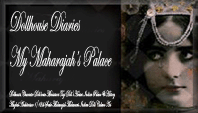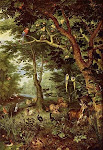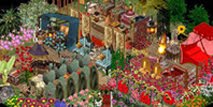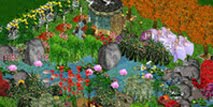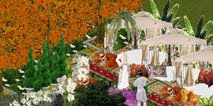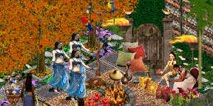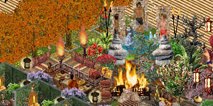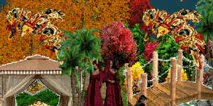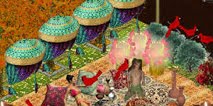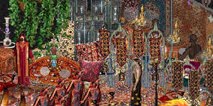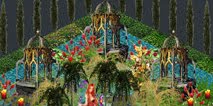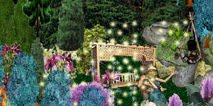In this book is a chapter on the different styles of historical American architecture with suggested colour schemes for the buildings. I see American dollhouses and thought dollhouse lovers may be interested in a list of the brief descriptions of the styles and recommended colour combinations. There are altogether 17 styles. I will cover them in 3 posts. All the words and images are from the book.
As the name suggests, the Cape Cod cottage originated in Massachusetts, with the first English settlers of Cape Cod. Typically one and a half stories high, the basic shape is low and broad to deflect seaside winds, with a pitched roof that slopes almost to the window tops. Capes were widespread through the first half of the 18th century, then underwent a revival in the mid 1920s, and they remain one of the most prevalent house styles in America. A popular Colonial colour was Spanish brown, a reddish brown often used on trim; white pale grey and pale yellow with black and green shutters have become favoured choices.
GEORGIAN
The term "Georgian " refers to the first period of formal architectural design to America, and is named for the succession of kings on the English throne before and during the Revolution. The classical-inspired style originated primarily in Britain, and was popular in the country from about 1700 to 1780. The uniform facades often feature matching end chimneys and symmetrically placed windows and doors trimmed with elegant classical details. The Georgian style resurfaced as part of the Colonial Revival around 1900 and remains extremely popular today. Many early Georgian houses were white. Dark browns and greys were also popular colours. Later in the eighteenth century, the fashion appears to have shifted from the darker shades to the lighter colours: creams, pale yellows, and more of the favoured white. Dark green used primarily for shutters, came into style around 1800.
GREEK REVIVAL
Inspired partly by archeological discoveries in ancient Greece, the Greek Revival was fashionable in America from about 1820 to the 1840s. Architect's pattern books spread the style to rural areas, where country builders and carpenters adapted it to the familiar "temple front" house. This form is often fronted by a classical portico, one of the style's distinguishing features. Early 19th century promoters of the Greek Revival style advocated the pale creams and whites they associated with classical architecture and these remain the favoured colours, shutters in a dark colour add a traditional accent.
CARPENTER GOTHIC
Carpenter Gothic was part of the general Gothic Revival movement, which took off in the 1830s and lasted until around 1875, and feature steeply pitched gable roofs (often with elaborate decorated trim) arched Gothic windows and intricate "gingerbread" porch and cornice decorations cut with a jigsaw (hence the term "carpenter"). Although the European prototypes were stone, American builders were also happy to use the abundant supply of native wood. Andrew Jackson Downing, an early advocate of the style, recommended grey and fawn to harmonise with "any situation in the country". However, less conventional colours were not unheard of. One of the best known Carpenter Gothic-style houses in New England, the Bowen House in Woodstock, Connecticut, was painted bright pink.
STICK
Stick is perhaps too stark a word for this picturesque style, named for the elaborate, decorative criss-cross stick work. The Stick style probably developed as resort architecture in the mid 1850s and some of its most famous examples are found in New Port, Rhode Island, and seaside communities in New Jersey. But the style spread across the country and remained popular well in the 1870s. These lighthearted often brightly coloured buildings can still be found in resorts, suburbs and small towns, mostly in the Northwest and Midwest. Typical body colours were pale pastels, pinks or light blues or sea greens, with the trim in a darker shade.
ITALIANATE
True to its name, this elegant, old-world style was meant to evoke the country village of Tuscany and Umbria. Italianate houses were popular from about the 1830s to the 1870s, and featured a square profile and very low roof with deep overhanging eaves and often a "belvedere" centered on top. Typically, the body colours were natural shades, inspired by their European prototypes, such as pale tan and greys, beiges and light browns with dark doors and windows sashes.
QUEEN ANNE
Queen Anne-style houses, popular between about 1870 and 1910, feature ornate asymmetrical facades distinguished by bay windows, towers, protruding gables and large verandahs. The eclectic style was rooted in the work of the British architect Richard Norman Shaw, whose highly original designs incorporated a free mix of many styles.Among the favoured colours for this style in America is muted browns, maroon, olive and terracotta. It was not uncommon to combine as many as three different colours on the main body of the house, with still more colours used to pick out the elaborate ornamentation typical of the style.



























